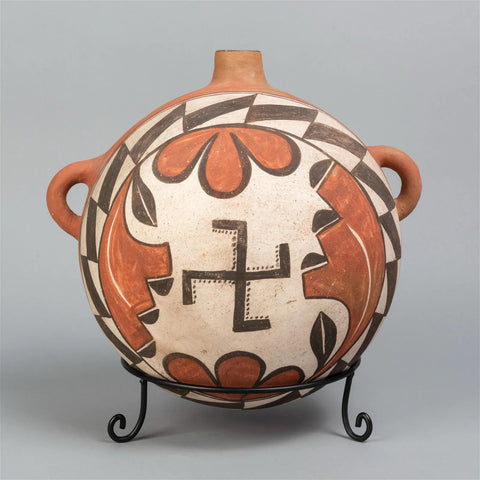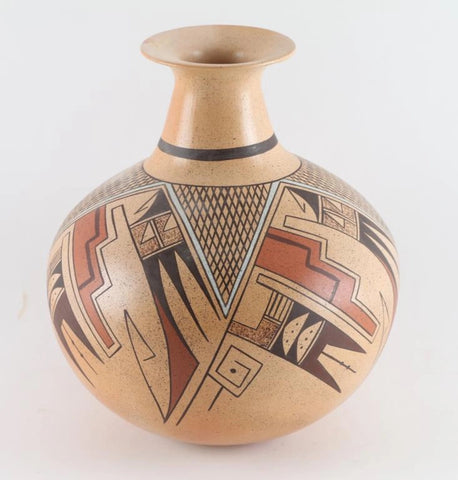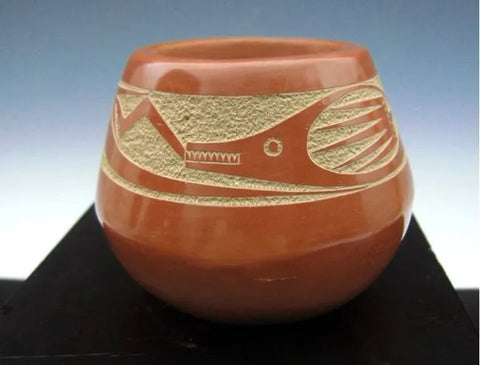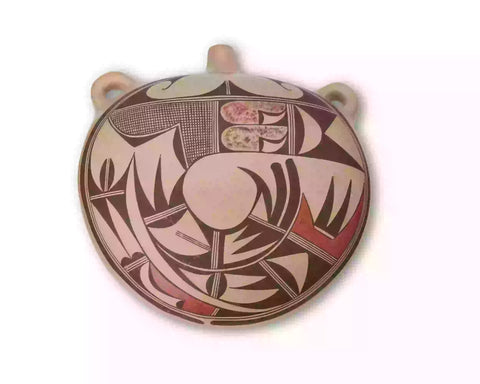
Blackware : Native American San Ildefonso Pottery Blackware Vase signed by Maria and Popovi Da #234
$ 2,400.00
Blackware
234. Description: Maria Montoya Martinez (1887-1980) and Popovi Da (1922-1971) San Ildefonso Black Ware vase signed underfoot Maria Poveka Height 5".
San Ildefonso pottery, immortalized by Maria Martinez, did more than transform an industry and pueblo; it has become an art form reserved for museums worldwide. From Maria and Julian Martinez to Blue Corn, Popovi Da, Tse-Pe, and countless other artisans San Ildefonso black-on-black pottery has become a form of economic sustenance and a high expression of art.
Located 23 miles north of Santa Fe, New Mexico, San Ildefonso pueblo has long been considered the epicenter for the pueblo pottery movement. This is the birth place of Maria Martinez and the newer form of San Ildefonso pottery. The famous black-on-black pottery, once a token tourist piece, now graces the highest mantles and shelves of museums worldwide.
A growing interest in Native American by anthropologists and archeologists of the Smithsonian Institution led to the excavation of Avanyu black-on-black pottery and subsequent attempt to emulate the pottery by Maria Martinez. The attempt to emulate an older style spawned a new form of firing pottery.
Maria Martinez and San Ildefonso Pottery: Maria Martinez (1887? - 1980) and her husband Julian did more than discover a method of firing pottery in a low oxygen environment and create a blackened, opulent pottery. They transformed a pueblo and created a movement that benefited Native Americans and spawned an art form worthy of worldwide recognition.
In the early 1900's, Julian was part of an excavation team working with Dr. Edgar Lee Hewett, Director of the Museum of New Mexico. Maria was also aiding, responsible for feeding the excavation team. During the excavation Maria discussed with Dr. Hewett the older pottery and pieces. Julian and Maria worked to create a finish similar to that of the older pottery. Though it is argued they never succeeded, their trials spawned a glowing black pottery. In fact, the early experiment pieces did not have markings. It was not until approximately 1915 that designs were applied. Julian first tried to apply traditional ink to the pottery. However, because of the higher temperatures, the ink would burn off. Julian developed a way to mix ink and clay in order to develop an application that would not burn off during firing.
This was not the first attempt at pottery for Maria and Julian. It is often overlooked that Maria and Julian were already accomplished poly chrome potters. What is overlooked is that the earlier pieces of Maria and Julian did not reflect the older decorations. When older pieces were excavated Maria and Julian would take note. Even in the early days, Maria would form the vessel and Julian would paint the vessel. The combined team would help create the black-on-black pottery so famous today.
The famous San Ildefonso pottery of today has only been brought to prominence by a family, but an entire pueblo. Though Maria could have easily kept the methods a family secret, to be shared with only her children (Adam & Santana, John, Phillip, and Popovi Da), she chose to share her information. Numerous potters, all of various skills, contributed to the rise in prominence of this pottery. The sharing of methods and designs contributed to the well-being of the entire pueblo and allowed a pueblo to become self-reliant and with a form of sustenance.
Similar to most pueblo artists, regardless of pueblo, it was (and still is) a 'family affair' in the creating of pottery. If only in the collecting of materials, family members contributed at all stages. Maria's pottery has numerous signatures of people who helped with the decoration. See below for a list of signatures and approximate date.
The making of San Ildefonso pottery is a laborious task requiring great skill. From the gathering of the clay, forming of the vessel, painting, and finally, the firing, the potter may have vested 15-50 hours per vessel. (Source: Sanildelfonsopottery.com)
Pueblo pottery is made using a coiled technique that came into northern Arizona and New Mexico from the south, some 1500 years ago. In the four-corners region of the US, nineteen pueblos and villages have historically produced pottery. Although each of these pueblos use similar traditional methods of coiling, shaping, finishing and firing, the pottery from each is distinctive. Various clay's gathered from each pueblo's local sources produce pottery colors that range from buff to earthy yellows, oranges, and reds, as well as black. Fired pots are sometimes left plain and other times decorated most frequently with paint and occasionally with applique. Painted designs vary from pueblo to pueblo, yet share an ancient iconography based on abstract representations of clouds, rain, feathers, birds, plants, animals and other natural world features.
Tempering materials and paints, also from natural sources, contribute further to the distinctiveness of each pueblo's pottery. Some paints are derived from plants, others from minerals. Before firing, potters in some pueblos apply a light colored slip to their pottery, which creates a bright background for painted designs or simply a lighter color plain ware vessel. Designs are painted on before firing, traditionally with a brush fashioned from yucca fiber.
Different combinations of paint color, clay color, and slips are characteristic of different pueblos. Among them are black on cream, black on buff, black on red, dark brown and dark red on white (as found in Zuni pottery), matte red on red, and poly chrome a number of natural colors on one vessel (most typically associated with Hopi). Pueblo potters also produce un-decorated polished black ware, black on black ware, and carved red and carved black wares.
Making pueblo pottery is a time-consuming effort that includes gathering and preparing the clay, building and shaping the coiled pot, gathering plants to make the colored dyes, constructing yucca brushes, and, often, making a clay slip. While some Pueblo artists fire in kilns, most still fire in the traditional way in an outside fire pit, covering their vessels with large potsherds and dried sheep dung. Pottery is left to bake for many hours, producing a high-fired result.
Today, Pueblo potters continue to honor this centuries-old tradition of hand-coiled pottery production, yet value the need for contemporary artistic expression as well. They continue to improve their style, methods and designs, often combining traditional and contemporary techniques to create striking new works of art. (Source: Museum of Northern Arizona)




